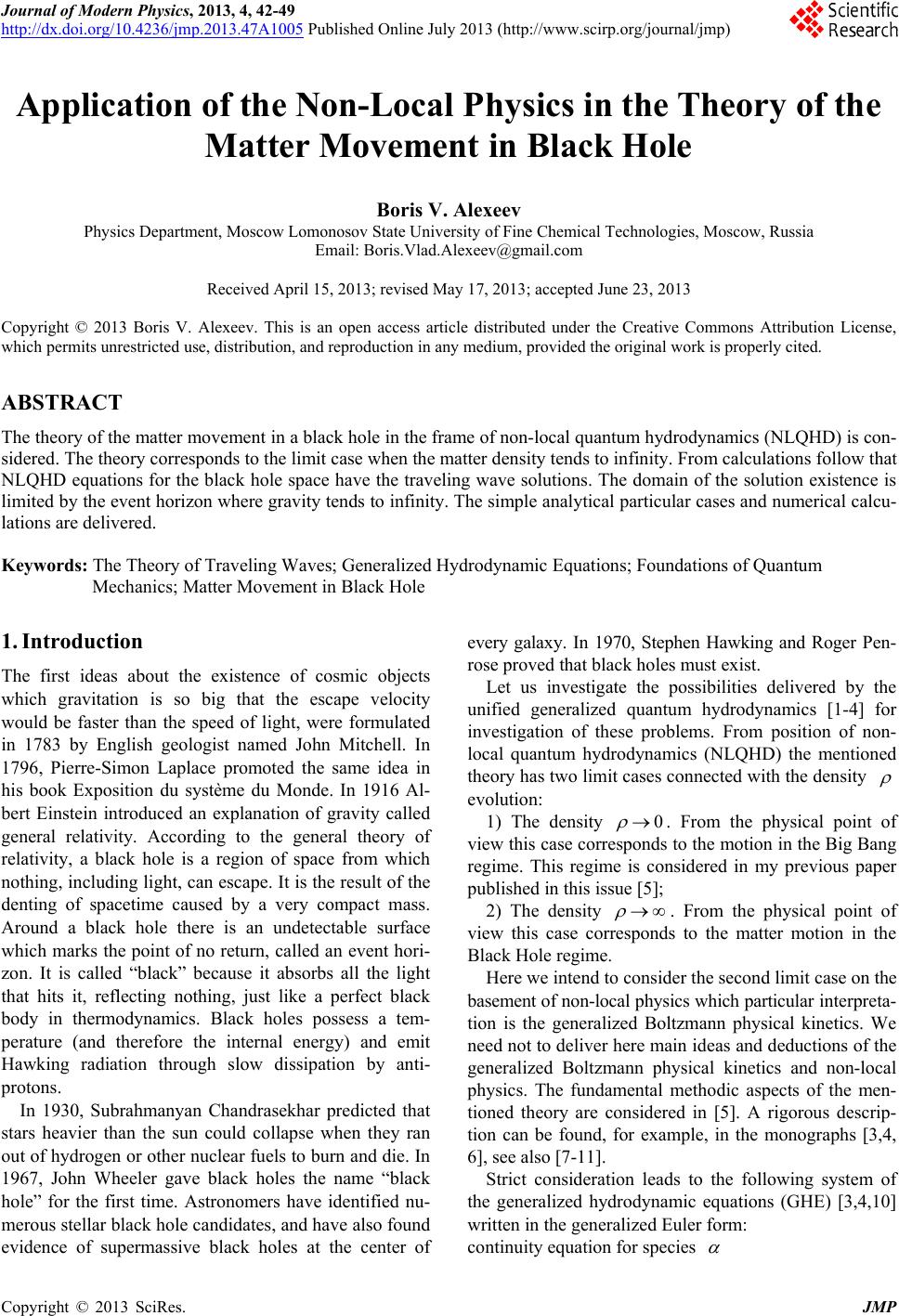
Journal of Modern Physics, 2013, 4, 42-49
http://dx.doi.org/10.4236/jmp.2013.47A1005 Published Online July 2013 (http://www.scirp.org/journal/jmp)
Application of the Non-Local Physics in the Theory of the
Matter Movement in Black Hole
Boris V. Alexeev
Physics Department, Moscow Lomonosov State University of Fine Chemical Technologies, Moscow, Russia
Email: Boris.Vlad.Alexeev@gmail.com
Received April 15, 2013; revised May 17, 2013; accepted June 23, 2013
Copyright © 2013 Boris V. Alexeev. This is an open access article distributed under the Creative Commons Attribution License,
which permits unrestricted use, distribution, and reproduction in any medium, provided the original work is properly cited.
ABSTRACT
The theory of the matter movement in a black hole in the frame of non-local quan tum hydrod ynamics (NLQHD ) is con-
sidered. The theory corresponds to the limit case when the matter density tends to in finity. From calculations follow that
NLQHD equations for the black hole space have the traveling wave solutions. The domain of the solution existence is
limited by the event horizon where gravity tends to infinity. The simple analytical particular cases and numerical calcu-
lations are delivered.
Keywords: The Theory of Traveling Waves; Generalized Hydrodynamic Equations; Foundations of Quantum
Mechanics; Matter Movement in Black Hole
1. Introduction
The first ideas about the existence of cosmic objects
which gravitation is so big that the escape velocity
would be faster than the speed of light, were formulated
in 1783 by English geologist named John Mitchell. In
1796, Pierre-Simon Laplace promoted the same idea in
his book Exposition du système du Monde. In 1916 Al-
bert Einstein introduced an explanation of gravity called
general relativity. According to the general theory of
relativity, a black hole is a region of space from which
nothing, including light, can escape. It is the result of the
denting of spacetime caused by a very compact mass.
Around a black hole there is an undetectable surface
which marks the point of no return, called an event hori-
zon. It is called “black” because it absorbs all the light
that hits it, reflecting nothing, just like a perfect black
body in thermodynamics. Black holes possess a tem-
perature (and therefore the internal energy) and emit
Hawking radiation through slow dissipation by anti-
protons.
In 1930, Subrahmanyan Chandrasekhar predicted that
stars heavier than the sun could collapse when they ran
out of hydrogen or other nuclear fuels to burn an d die. In
1967, John Wheeler gave black holes the name “black
hole” for the first time. Astronomers have identified nu-
merous stellar black hole candidates, and have also found
evidence of supermassive black holes at the center of
every galaxy. In 1970, Stephen Hawking and Roger Pen-
rose proved that black holes must exist.
Let us investigate the possibilities delivered by the
unified generalized quantum hydrodynamics [1-4] for
investigation of these problems. From position of non-
local quantum hydrodynamics (NLQHD) the mentioned
theory has two limit cases con nected with the dens ity
evolution:
1) The density 0
. From the physical point of
view this case corresponds to the motion in the Big Bang
regime. This regime is considered in my previous paper
published in this issue [5];
2) The density
. From the physical point of
view this case corresponds to the matter motion in the
Black Hole regime.
Here we intend to consider the second limit case on the
basement of non-local physics which particular int er pre ta-
tion is the generalized Boltzmann physical kinetics. We
need not to deliver here main ideas and deductions of the
generalized Boltzmann physical kinetics and non-local
physics. The fundamental methodic aspects of the men-
tioned theory are considered in [5]. A rigorous descrip-
tion can be found, for example, in the monographs [3,4,
6], see also [7-11].
Strict consideration leads to the following system of
the generalized hydrodynamic equations (GHE) [3,4,10]
written in the generalized Euler form:
continuity equation for species
C
opyright © 2013 SciRes. JMP